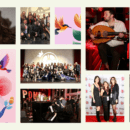H-pem Editor and Content Manager Rupen Janbazian and Lilly Torosyan, Assistant Project Manager.
Hamzkayin Central Executive Board recently announced the launch of h-pem.com, it’s web-based platform designed to enhance Armenian cultural interaction between diasporan communities and Armenia and to foster the Armenian global identity through myriad cultural experiences.
TorontoHye conducted the following interview with Rupen Janbazian, Editor and Content Manager (Canada) and Lilly Torosyan, Assistant Project Manager (USA).
Interview Conducted by Varak Babian
Varak Babian: For those who share an innocent ignorance towards details surrounding this new and exciting project, how and when was the idea of h-pem conceived? How long did the transition from idea to “clickable reality” take?
Rupen Janbazian: The creation of a platform to engage young Armenians (and non-Armenians) with Armenian culture in the English language is a long time coming and I believe that there has been a serious need for such a space in the Armenian reality for years now.
Luckily, back in 2014, Hamazkayin Armenian Educational and Cultural Society’s seventh International General Assembly outlined the creation of an innovative online platform to more effectively implement the now 91-year-old organization’s mission and to reach a mass of Armenians in the diaspora—specifically the Diasporan Armenian youth—which had largely been left out of the conversation. It’s not to say that English-language Armenian publications do not exist—they have been around for several decades and continue to serve a very important purpose. The idea for creating h-pem was meant to start something that we did not previously have—to use Armenian arts and culture as the focal point to create a space for creative engagement, conversation, and participation.
To ensure the success of the project, the h-pem committee and our project manager Loucig Guloyan-Srabian held consultations and brainstorming sessions with English-speaking Armenian youth across the world, well before Lilly or I joined the team. After several months of careful planning and development, h-pem, was launched and made available to the public in May.
V.B.: What makes h-pem stand out as more than just another stop on the internet highway when compared with the numerous media outlets and social media accounts growing their own online presence.
Lilly Torosyan: I think what makes h-pem so special is that it is not just one thing that appeals to one type of person: A third generation Armenian from a small town in the Midwest U.S. can get just as much out of our site as a newly-arrived immigrant from Beirut.
One of our goals is to provide a welcoming environment for young Armenians to tap into the many facets of their identity. How do we do this? At our core, we value respect and authenticity. By dignifying all genuine voices, we hope to create a community of trust, and the inevitable result of such a formula is high quality content.
V.B.: How does the h-pem platform decide what kind of content is acceptable or appropriate to be shared? Can you share some of your screening and submissions processes with us?
R.J.: One of our main objectives at h-pem is to introduce the many different facets of the Armenian culture—from both the homeland and the worldwide diaspora—to the public. In order to do that, we accept a wide array of content, which present different viewpoints, perspectives, and ideas in innovative ways.
Like I mentioned earlier, h-pem is not a conventional Armenian publication: Our mission is not to become a news outlet or magazine in the traditional sense. Though we do have a number of regular contributors, we strongly believe in creating a collaborative space—a “bottom-up” approach, in which our users have a place to be a part of the conversation. That being said, we strive to create a space that is driven by quality and professionalism. After submitting to h-pem, our editorial team will review proposals and pieces and collectively make a decision regarding publication. As Lilly mentioned, at our core, we value quality and authenticity and we hope the pieces which we publish reflect that.
Practically speaking, our platform is divided into two main parts: Our “Featured content,” in which you will find pieces written by our many contributors, and “Your stage,” a space in which our users’ work will be highlighted.
The “Featured content” portion of our site is h-pem’s online magazine, which includes stories, interviews, analyses, and profiles of Armenian cultural figures and achievers, as well as stories in pictures. “Your stage” is more of an experimental space, which includes a multimedia guide and a submissions area, where we encourage aspiring and established artists to introduce and share their creative output. “Your stage” also features a section strictly for collaborations, where we collaborate with artists, writers, cultural executives, students, and graduates from multiple disciplines, as well as organizations, institutions, and community members, on focused projects. For example, Lilly led an awesome collaboration with last year’s interns at the ANCA (Armenian National Committee of America), which yielded some thought-provoking and heartfelt pieces (check them out here: https://www.h-pem.com/en/collaborations/2018/08/15/from-the-capital-to-the-interwebs/15).
We are currently also experimenting with live streaming Armenian cultural events, which will allow folks from around the world to tune in on the go or from the comfort of their home and give them the opportunity to interact and provide commentary in real-time.
We encourage anyone who is interested in Armenian culture to become an active user, to pitch a story to us, to submit their own work, to suggest a collaboration or a live-stream, and to become a part of the conversation on existing content on the platform by commenting on our website and social media accounts.
V.B.: It is often said that it “takes a village to raise a child.” How many pairs of eager shoulders, both individuals and organizations, have carried and helped expedite the workload attached to launching and maintaining a living, breathing online identity?
L.T.: I love this expression because I think it absolutely applies to h-pem—not just its conception or launch (indeed, many souls were integral to the birth of this project and where we are now)—but also in the ongoing process of, as you say, “maintaining a living, breathing online identity.” In many respects, h-pem is a village. I’ve described it as “a fortress into a bustling, dynamic world of Armenian culture.” Sure, the fortress may not be literal, but that does not make it any less real. If anything, our virtual nature could be viewed as a positive. We are all familiar with some of the hurdles of maintaining an online presence, but the beauty of our website is that we are not tied to yesterday’s constraints.
R.J.: The creation of this platform would not be possible without Hamazkayin, an organization, which has done so much in terms of the preservation and promotion of Armenian education and culture in both the diaspora and the homeland since 1928. The Hamazkayin Central Executive’s h-pem committee has been dedicated to the project since its inception and have played an integral part in making it a reality. Finally, h-pem’s small, but passionate team of four—our Project Manager Loucig and Management Assistant and Social Media Strategist Shahen in Beirut, along with Lilly in the States and me in Toronto—take pride in making the magic happen. I believe we each bring our unique set of experiences and ideas to the table. It’s been a fun ride so far!
L.T.: As a diaspora with seeds spread across the world, we quickly learned to be resourceful in our new communities, where our homelands were out of physical touch but always in our hearts, minds, and souls. At h-pem, we grapple with the idea of a homeland, as it exists for us in the present, and what it means to different people, just as we do with identity, Armenianness, Armenian art, music, food, literature, film, and a host of other factors. We realize that anything that is posted online remains there forever, so in addition to creating, shaping, and painting culture of the present day, we are simultaneously writing our own history books. What a time to be alive!
V.B.: H-pem proclaims the importance of “boosting cultural responsiveness in creative and cooperative ways” As no culture is a monolith, how difficult is it to try to present a concept of a global Armenian reality. Is there such a thing?
L.T.: You are absolutely right that there is no such thing as “a” global Armenian reality. There are many! The beauty of our culture, our people, and our history is that we are diverse, with many different voices, perspectives, and stories that make up our collective identity. H-Pem honors the multifaceted nature of our Armenian realities by highlighting a multitude of Armenian voices, perspectives, and stories from anyone who falls under the label of “Armenian.” Some have been more visible than others, and while we do not want to negate those perspectives, we want to also provide an opportunity for other perspectives to tell their stories.
We believe that the best way to present “an Armenian reality” is to highlight all of its angles. H-Pem’s model is to do this through cooperation, mutual respect, love (for each other and for our common goal), and an utmost passion and dedication for our culture, our art, and our people.
V.B.: What does h-pem hope to contribute to the current, ongoing diasporan dialogue?
L.T.: We hope that h-pem will highlight the many voices engaged in the diasporan dialogue. We seek to build bridges between different diasporan communities, as well as with Armenia. We do not shudder at our differences, but rather see an opportunity to shine a light on the beauty of each perspective. Every Armenian has a unique story to tell, and to create a hierarchy of what is deemed “acceptable”, or—worse—to limit certain voices, would be a massive disservice to our beautiful culture. H-pem is, quite literally, a “stage” for all Armenians—especially the newest generation(s)—to play an active role in creating culture, not just digesting it.
V.B.: One continuously contentious issue within the field of preservation of modern Armenian identity and culture is the role played by language. How do you respond to the inevitable naysayers who will find issue with h-pem using English as its primary language?
L.T.: I want to place an emphasis on the following: We love the Armenian language. Period. There is absolutely no doubt in our minds, or in our hearts, about the importance, beauty, and uniqueness of the Armenian language. With that being said, we also acknowledge the reality of the diasporan experience—particularly in the West—where the Armenian language is slipping away and in desperate need of revival.
R.J.: Vatche Papazian, a Beirut-based member of Hamazkayin’s h-pem committee and an integral part of our endeavor, probably said it best: “Our medium is English, but our purpose is Armenian.” We strongly believe that Armenian—a language that has been spoken by our people for millennia—is central to our cultural identity. Absolutely. However, we also believe that it is vital that the many facets of the Armenian culture be experienced. Whether it’s in Armenian or English, or any other language, for that matter, it must be experienced.
Through h-pem, we hope to bring our culture to the English-speaking world—to Armenians who aren’t proficient in the Armenian language and to non-Armenians wishing to learn more.
L.T.: In presenting our site in English, we are not eschewing or negating the importance, beauty, or uniqueness of the Armenian language, but simply acknowledging this stark reality. Pretending that a problem doesn’t exist does not do anything to solve it. I cannot tell you how it pains me when I meet a group of what we would deem “assimilated” Armenians and among the handful of Armenian words they know are “otar” (“foreigner”) and “amot” (“shame”). Resurrecting the Armenian language will take a lot of work, but naming and shaming is not the way. We have several articles (yes, in English) about the importance of the Armenian language and resources for learning it. We tell stories about language from a personal lens, and at the root is love, not shame or guilt.
R.J.: Shaming and guilting will only deter and discourage a large portion of young Armenians from embracing their people’s history, traditions, and culture. We can’t afford to “write off” these folks just because they feel more comfortable speaking, reading, and engaging in a language other than Armenian. From my personal experiences in both Canada and the U.S., I can say that there is no lack of interest—we simply have to start “speaking the right language” (no pun intended!) to reach them.
Instead of playing the blame game, which will surely turn folks away even more from their Armenian identity, it’s more effective to find novel, innovative ways and methods—like our platform—in order to re-establish that invaluable relationship and connection.
L.T.: We hope that using such a perspective will make the reader—wherever they are, whoever they are—want to learn, not because of shame or obligation, but because of the desire to connect deeper with their roots, their ancestors, their families, their community—whomever they so choose. One cannot love a culture—or a tongue—without understanding it and connecting with it personally, so in making this language more accessible to what traditionally may have been deemed a “lost” community, we hope to reverse this trend and bring these Armenians back into the fold in a deeper, more genuine way.
V.B.: How do we balance creating and thriving in another “New Armenia,” without increasing the disconnect with the motherland and her own unique variations and conditions?
R.J.: I was lucky enough to grow up in Toronto, where remaining Armenian was not merely possible, but which also afforded numerous opportunities for doing so; I grew up appreciating the importance of our schools, churches, Armenian centers, and organizations here. Throughout the years, though, I have also grown to recognize what it means to be a people with a country—to have a nation, which can help ensure that our millennia-old culture is not only preserved but also allowed to thrive.
Going beyond becoming just another “New Armenia,” which some may characterize as being another disconnecting agent between Armenia and the diaspora, I believe that h-pem can become the first step in introducing the richness of our people to a group that has not been able to experience it previously. I firmly hold that this can help bolster and strengthen the interactions between the dispersed masses of Armenians in the diaspora and the Armenian homeland.





